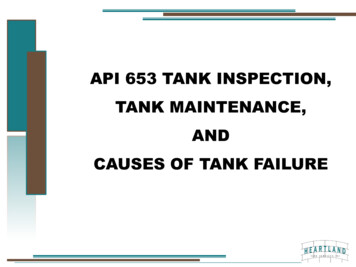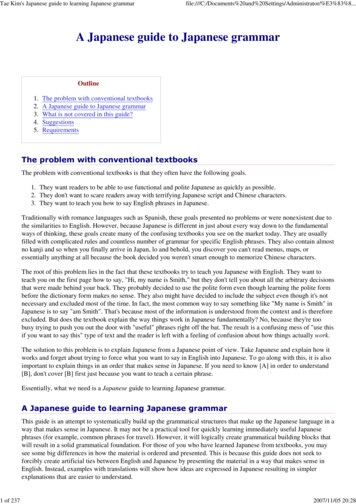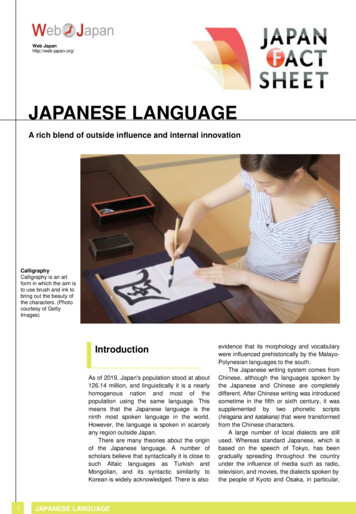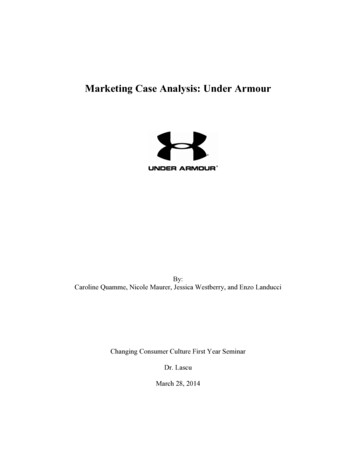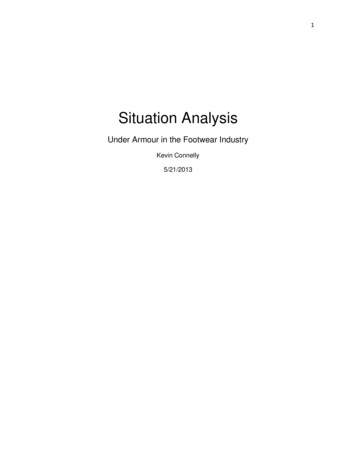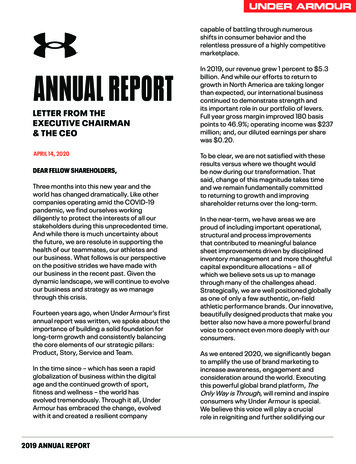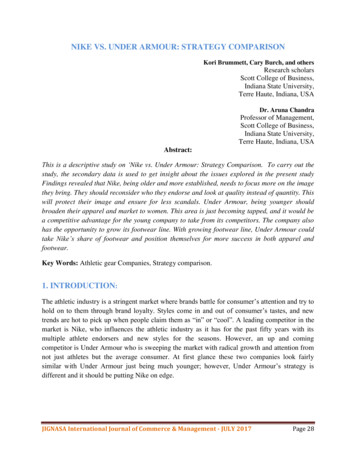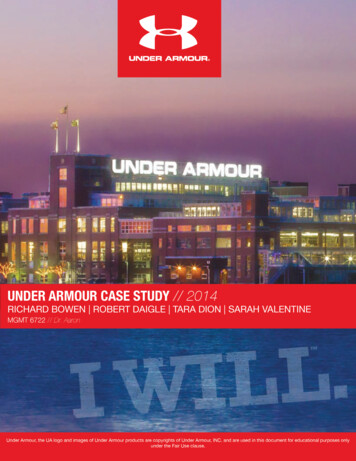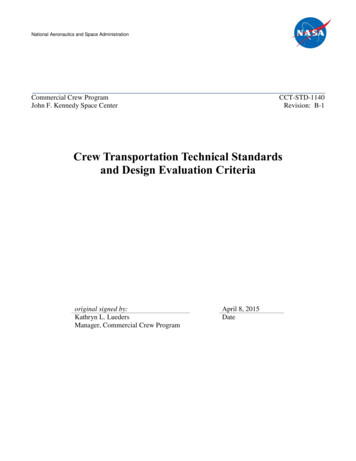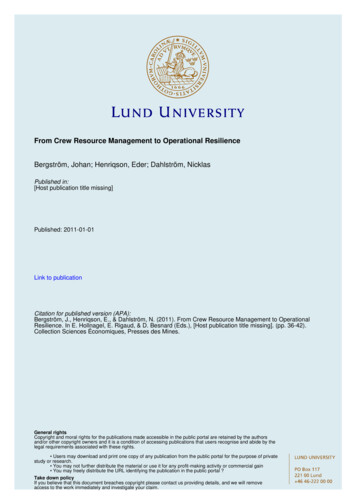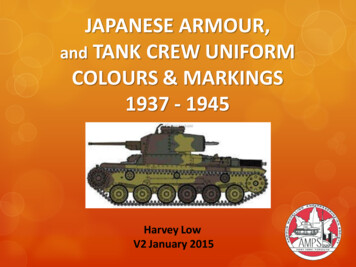
Transcription
JAPANESE ARMOUR,and TANK CREW UNIFORMCOLOURS & MARKINGS1937 - 1945Harvey LowV2 January 2015
A Note on ColoursColours quoted in this reference guide should be used with the following in mind:1. IMHO colour matches are not a science in that it is impossible for one single mix(i.e., FS) to represent an original subject colour. Rather it is a range of colour mixes.2. Thus colours are noted here as standards only.3. Colours change as a result ofa) inconsistent factory mixing & manufacturing limitationsb) conflicting standards and ordersc) expediencyd) field application interpretatione) Weathering4. Lighten colours with pure white for scale effect:a) 1/35 (5% - 10%)b) 1/48 (10% - 20%)c) 1/72 (20 % - 30%)
http://www.about.com/homegardenTONE - how light or dark a color is.HUE - what the actual color is.Some RULES- lighter hues produce a smaller range of tones- using black and white are not the only colours to change a hue
Camouflage SummaryColors will be referred to in their common English terms (e.g., “Khaki”) followed byJapanese equivalent terms. Early Period 1937-1942 (China, SE Asia, Home Islands, SW Pacific): Three tone scheme of base colour Khaki Drab (Tsuchi kusa-iro), Dark Brown (Tsuchi-iro), and LightBrown (Karekusa-iro). Pre-’37 base colour also a Reddish-Brown(?). Use of Grass Green (Kusa-iro) often substituted for Light brown, after 1941. Mostly hard-edged. Some use of yellow disruptive bands, with some black outlining. Surface ratio coverages are 50% Khaki (Tsuchi kusa-iro), 30% Dark Brown (Tsuchi-iro), and Karekusa-iro(20%). Later Period 1942-1945 (SW Pacific): Three tone scheme of base colour Grass Green (Kusa-iro), Dark Brown (Tsuchi-iro), and Light Brown(Karekusa-iro). Mostly hard-edged but some soft towards end of war. Surface ratio coverages are 50% Grass green (Kusa-iro now base), 30% Dark Brown (Tsuchi-iro), andKarekusa-iro (20%). The 1942 regulations suspended the use of all black outlining, and Yellow bands. Naval landing Force (SW Pacific): Amphibious tanks were an overall dark blue grey (Naval color?) as well as Dark and Olive Greens. Thisvaried however by type of tank (e.g., Type 89’s were never grey(?)). Later war photos (1943 on) clearly show hard-edge two-tone disruptive colors (speculative as to actualcolours). Yellow bands painted between colors and starting at top of turret roof. Conjecture remains as to color: paleyellow vs. light beige (“Dry grass”).
Japanese Tank Colours – Interpretations by Harvey Low (Jan15)ColorJapanese TermTAMIYAGUNZE ACRYLICMIGKhaki Drab (earthgreen, khaki drab,mustard)Tsuchi kusa iro (orTuchi/Tuti/Tochi kuka iro)XF-49 KhakiH81 JapaneseArmy UniformMIG-071 KhakiDark Brown (darkearth, chocolatebrown, dark redbrown)Tsuchi iro (orTuchi/Tuti/Tochi iro)XF-9 Hull Red(45%) XF-68Nato Brown(45%) XF-69Nato Black(10%)H84 MahoganyMIG-070 MediumBrownLight Brown (dryparched grass, lightearth, ochre, middlestone)Karekusa iroXF-49 Khaki(60%) XF-60Dark Yellow(15%) XF-4Yellow-Green(15%) XF-67Nato Green(10%)H71 Middle StoneGrass Green (twoversions - dark andolive green, bluegreen, bright willowgreen)Kusa iroDark Version:XF-13 IJAGreenH340 Field GreenPost ‘42 LightVersion: XF-67Nato GreenH58 (InteriorGreen)Blue-Grey (dark bluegrey, medium grey)XF-75 IJN GrayKureH83 IJN Gray 2Pale Yellow (offyellow, canary yellow)XF-4YellowGreen (50%) XF-59 DesertYellow (50%)NOTES:Base Colour andPrimer (early war)Alternate DarkerVersion: XF-64Red Brown (50%) X-6 Orange(40%) XF-59Desert Yellow(10%)MIG-069 Blue-GreenBase Colour andPrimer (later war)Found on late warNaval Armour(e.g., Ka-mi andKa Chi amphibioustanks)Naval LandingForce onlyMIG-048 YellowBands betweenthe colors (up to1942/43)
Other Notes Often lower portions (barrels, wheel areas) were sometimes painted Light Brown (Karekusa-iro). No standardization of tank markings. Single Kana or kanji character, were found on hull and/or turret sides, almost always in white. This single character would signify vehicles belonging to the same group or “Chutai”. Numerals also found on hull sides, almost always in white (most prevalent up to 1941 and limitedafter that). License plates found on all tanks consisting of black colored plate with white markings. Army Starfollowed by two Kanji characters (“Sen” or “Shensa” meaning “tank” and Kanji numeric noting theUnit). This was then followed by a random number in Arabic numerals representing a specific tank.Naval tanks were noted with an Anchor and usually no Kanji Unit designation. Arm of service on front hull was brass, but mostly painted the same color as the camouflage asthe war progressed. Unlike Germans, Japanese Air Force did not operate tanks or fighting vehiclesof their own. Construction battalions (aka. Like Sea-Bees) had unique Badge of an Anchor withcross tools.
Historic photos from various websites including:Amorama, WW2incolor, worldoftanks,wikipedia, clubsnap, Collectors Guild, Missing-Linx and Akira Takizawa.
Note hard edge camouflage.
Note small Nippon Flags on front hull!Significant track sag!
Note “License Plate” on rear upper hull position.
Hard edge camo on Type 2.
1/35 scratchbuilt model by Harvey Low
1/35 model by Harvey Low
1/72 model by Harvey Low
1/35 conversion model by Harvey Low
Many tankers wore more comfortableforage caps as well, when not in combat.
Note name tag on uniform, even thoughJapanese used “dog tags”.YES Tankers carried swords!
Note crewmen wear coveralls.
Harvey Low collection
Harvey Low collection
Harvey Low collection
Harvey Low collection
Harvey Low collection
Harvey Low collection
Harvey Low collection
Japanese “Dog Tags”. String is not original.Harvey Low collection
Japanese Army Map CaseHarvey Low collection
Type 98 “Knee Mortar”. An infantry weapon,But sometimes carried by Tank Crew asSecondary weapon due to its portability.Harvey Low collection
Harvey Low collection
Harvey Low collectionSUMMER TANKER JACKETWINTER TANKER JACKET
Harvey Low collection
Note paint splatter on sleeve!Harvey Low collection
Useful References1.Handbook on Japanese Military Forces 1.html)2.Hirano Yoshitaka. “Chi-Ha Colours” in Armour Modeling (Vol.3).3.“Japanese Army Camouflage Regulations 1942”. published in Panzer (January 1976).4.Suzuki Junihiro. “Camouflage Pattern and Insignia of Imperial Japanese Army ArmouredUnit s”, in Armour Modeling (Vol.2).5.Millmann, Nick. Japanese Armour Colours – A Primer. 2012.6.Zaloga, Steve. Armor of the Pacific War (Vanguard #35), Osprey, 1983.7.Zaloga, Steve. “Japanese Tank Markings, 1941-1945 (pp.394-400)”, in Airfix Magazine (March 1977).Harvey LowPresidentAMPS FORT YORK TORONTOFor personal use only and not for profit.Use of colour reference materials must source the author.
7. Zaloga, Steve. “Japanese Tank Markings, 1941-1945 (pp.394-400)”, in Airfix Magazine (March 1977). Harvey Low President AMPS FORT YORK TORONTO For personal use only and not for profit. Use of colour reference materials must source the author.
